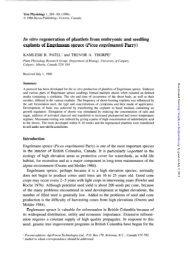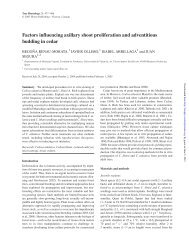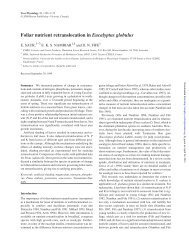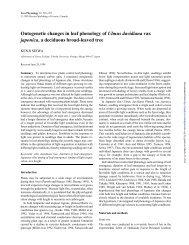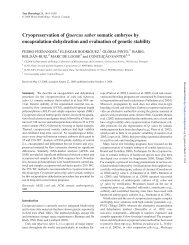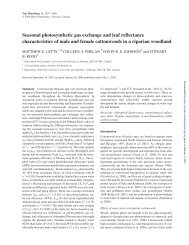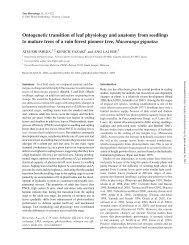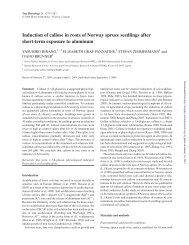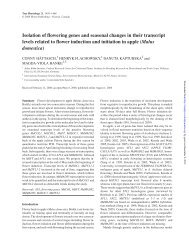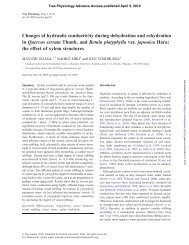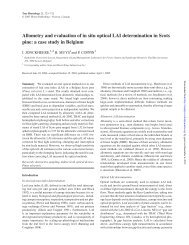Sucrose (JrSUT1) and hexose (JrHT1 and JrHT2 ... - Tree Physiology
Sucrose (JrSUT1) and hexose (JrHT1 and JrHT2 ... - Tree Physiology
Sucrose (JrSUT1) and hexose (JrHT1 and JrHT2 ... - Tree Physiology
You also want an ePaper? Increase the reach of your titles
YUMPU automatically turns print PDFs into web optimized ePapers that Google loves.
SUCROSE AND HEXOSE TRANSPORTERS IN WALNUT XYLEM PARENCHYMA 219<br />
transporters from other species. Thus, it has been used as a homologous<br />
probe to screen a xylem-tissue-derived cDNA library<br />
(Sakr et al. 2003). Two full-length cDNA clones encoding<br />
putative <strong>hexose</strong> transporters, <strong>JrHT1</strong> <strong>and</strong> <strong>JrHT2</strong>, were isolated.<br />
The complete nucleotide sequences of the clones <strong>JrHT1</strong><br />
<strong>and</strong> <strong>JrHT2</strong> contained an open reading frame of 1563 <strong>and</strong> 1524<br />
bp, respectively, <strong>and</strong> had 98% sequence similarity. <strong>JrHT1</strong> <strong>and</strong><br />
<strong>JrHT2</strong> encode 521 <strong>and</strong> 508 amino acid polypeptides, respectively.<br />
The putative amino acid sequence of <strong>JrHT1</strong> was aligned<br />
with the deduced protein sequences of known <strong>hexose</strong> transporters<br />
(Figure 3A). The identity between <strong>JrHT1</strong> <strong>and</strong> other<br />
<strong>hexose</strong> transporters ranges from 51 to 85%, <strong>and</strong> the closest<br />
identity was found with the RcSCP from Ricinus communis L.<br />
(Weig et al. 1994).<br />
Expression analysis of these putative <strong>hexose</strong> transporters in<br />
different organs was carried out by a semi-quantitative RT-<br />
PCR approach, with RNAs extracted from leaf, fine root, xylem,<br />
bark <strong>and</strong> flowers (male <strong>and</strong> female). Because the primer<br />
pair (Hex11/Hex12) is common to <strong>JrHT1</strong> <strong>and</strong> <strong>JrHT2</strong>, the amplified<br />
b<strong>and</strong> was named <strong>JrHT1</strong> <strong>and</strong> <strong>JrHT2</strong>. <strong>JrHT1</strong> <strong>and</strong> <strong>JrHT2</strong><br />
transcripts were detected in all of the tested organs, including<br />
the xylem tissue (Figure 3B), contrasting with the sink-specific<br />
expression of a cDNA encoding a putative sucrose transporter<br />
isolated by Decourteix et al. (2006) from walnut xylem<br />
tissue (JrSUTs; Figure 3B). No significant difference in transcript<br />
abundance of <strong>JrHT1</strong> <strong>and</strong> <strong>JrHT2</strong> was found between<br />
source leaf <strong>and</strong> sink organs (xylem, fine root <strong>and</strong> bark). The<br />
lowest abundance of <strong>JrHT1</strong> <strong>and</strong> <strong>JrHT2</strong> was in male flowers.<br />
Transcript patterns of <strong>JrSUT1</strong> <strong>and</strong> <strong>JrHT1</strong> <strong>and</strong> <strong>JrHT2</strong> during<br />
the growing season<br />
The relative transcript abundance of <strong>JrHT1</strong> <strong>and</strong> <strong>JrHT2</strong> <strong>and</strong> a<br />
putative sucrose transporter <strong>JrSUT1</strong> previously isolated from<br />
walnut xylem tissue by Decourteix et al. (2006) was examined<br />
by semi-quantitative RT-PCR as previously applied to walnut<br />
xylem tissue (Sakr et al. 2003, Decourteix et al. 2006). As<br />
shown in Figure 4A, the apical <strong>and</strong> basal stem segments exhibited<br />
a contrasting pattern of <strong>JrSUT1</strong> transcript abundance. In<br />
the apical segment, <strong>JrSUT1</strong> transcripts were abundant in<br />
March <strong>and</strong> April, whereas they were undetected in May <strong>and</strong><br />
June. In the basal segment, the transcript level of <strong>JrSUT1</strong> was<br />
high in April <strong>and</strong> June <strong>and</strong> low in March <strong>and</strong> May.<br />
The pattern of <strong>JrHT1</strong> <strong>and</strong> <strong>JrHT2</strong> transcripts differed from<br />
that of <strong>JrSUT1</strong> <strong>and</strong> between the apical <strong>and</strong> basal stem segments<br />
(Figure 4B). In the apical segment, <strong>JrHT1</strong> <strong>and</strong> <strong>JrHT2</strong><br />
transcripts were slightly more abundant in April <strong>and</strong> May than<br />
in March <strong>and</strong> June. In the basal segment, <strong>JrHT1</strong> <strong>and</strong> <strong>JrHT2</strong><br />
transcripts increased from March to May, but decreased in<br />
June.<br />
Accumulation <strong>and</strong> localization of sugar transporters during<br />
the growing season<br />
The affinity-purified anti-<strong>JrSUT1</strong> antibody labeled a single<br />
b<strong>and</strong> of 54 kDa on immunoblots, which is consistent with the<br />
molecular mass of several sucrose transporters (Lemoine<br />
2000). In the apical segment, b<strong>and</strong> intensity was highest in<br />
TREE PHYSIOLOGY ONLINE at http://heronpublishing.com<br />
Figure 3. (A) Comparison of the deduced amino acid sequence of<br />
<strong>JrHT1</strong> with those of other <strong>hexose</strong> transporters from mono- <strong>and</strong> dicotyledonous<br />
plants. The dendrogram was generated by comparison<br />
of the sequences by the CLUSTAL W 1.74 software (Higgins et al.<br />
1994). VvHT2 (Accession no. AAT77693); AtSTP1 (CAA39037);<br />
AtSTP4 (BAB01308); VfSTP1 (CAB07812); AtSTP9 (NP175449);<br />
AtSTP5 (CAC69071); AtSTP6 (CAC69073); AtSTP11 (CAC-<br />
69075); tMST2.1 (CAG27605); tMST2.2 (CAG27609); tMST3.1<br />
(CAG27606); ZmMST1 (AAT90503); PaMST1 (CAB06079); PMT1<br />
(AAC61852); LeHT2 (CAB52689); VvHT1 (CAA04511); RcSTC<br />
(AAA79761); OsMST3 (BAB19864). Percentage identity is noted on<br />
the right. (B) Expression patterns of JrHTs <strong>and</strong> JrSUTs in various organs<br />
of walnut tree. Semi-quantitative reverse transcriptase polymerase<br />
chain reactions (RT-PCRs) were performed with either<br />
Sut1A/Sut1B for JrSUTs, Hex11/Hex12 for JrHTs or Act11/Act12<br />
for JrAct. At least four RT-PCRs were conducted on each of the two<br />
biological replicates. All yielded similar results to those shown.<br />
March (early spring) <strong>and</strong> April (beginning of bud break),<br />
whereas no labeled b<strong>and</strong> was found in May <strong>and</strong> June (Figure<br />
5A). In the basal segment, the b<strong>and</strong> increased in intensity<br />
from March to April <strong>and</strong> disappeared in May <strong>and</strong> June. In<br />
March <strong>and</strong> April, there was more <strong>JrSUT1</strong> protein in xylem parenchyma<br />
cells of the apical than of the basal stem segments<br />
(Figure 5A).<br />
Downloaded from<br />
http://treephys.oxfordjournals.org/ by guest on December 27, 2012



